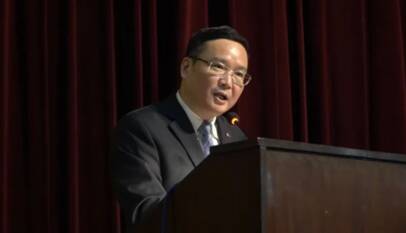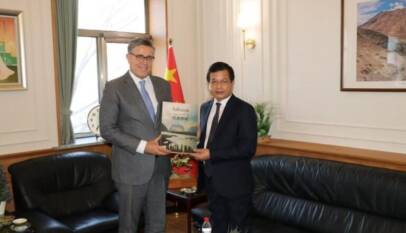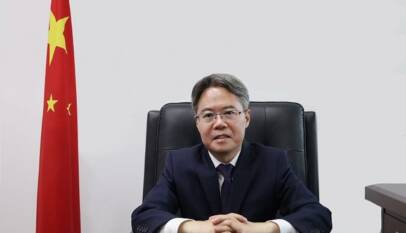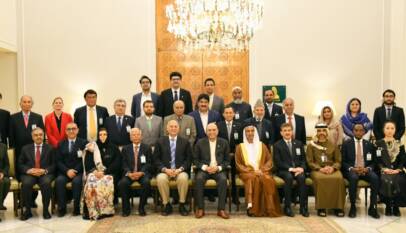Afghan Transit Trade via Gwadar port is set to stimulate business opportunities for locals along the western route of CPEC
The government of Pakistan has allowed the import and transit movement of Afghan cargoes through Gwadar port under the Afghanistan Pakistan Transit Trade Agreement (APTTA). The transit trade activities at the port and along CPEC western route will create business and employment opportunities for locals. Adviser to Prime Minister on Commerce Abdul Razak Dawood has informed that ships from China will also offload at Gwadar Port. He further asserted that Pakistani exports will be accelerated if Central Asian states and Russia get access to the Gwadar port.
Menwhile, it is noted that China continued to invest in CPEC projects despite the pandemic outbreak. the power sector of CPEC attracted the highest investment.
Ministry of Commerce (MoC) has allowed the import and transit movement of Afghan bulk cargoes of wheat, sugar and fertilizers at Gwadar port. According to the official document, the decision was taken on the requests of Federation of Pakistan Chambers of Commerce & Industry (FPCCI), Pakistan Afghanistan Joint Chamber of Commerce & Industry (PAJCCI), Gwadar International Terminals Limited and other stakeholders.
It said that stakeholders kept approaching the MoC, requesting to allow the import of Afghan bulk cargoes at the Gwadar Port and onward transit to Afghanistan in sealable trucks for long.
Later, in order to verify either the permission to allow the import of Afghan bulk cargoes at the Gwadar Port and onward transit to Afghanistan in sealable trucks is admissible or not, the MoC has examined their plea in light of the Afghanistan Pakistan Transit Trade Agreement (APTTA), 2010 and found that Article 21(1)(c) of the APTTA, 2010 allows transit of “bulk cargo (not imported in containers – like ship load) in open trucks or other transport units.
Therefore, in view of the mentioned provisions, the petitions of the stakeholders and for the sake efficient and cost-effective operationalization of the Gwadar Port and the Western-Corridor of the CPEC, the MoC has allowed import of Afghan bulk-cargoes of wheat, sugar and fertilizers at the Gwadar Port and onward transit to Afghanistan in bonded carrier, insured and sealable trucks having a tracking device installed on them. In addition, the customs authorities have also been directed by the MoC to take necessary and cost efficient measures to ensure the en-route security of the cargoes.
KARACHI: Despite the uncertainty caused by coronavirus pandemic, long-term foreign investors poured capital into different projects in Pakistan in power, oil and gas exploration and communication sectors during March 2020.
Foreign direct investment (FDI) surged 92% to $278.7 million in March compared to $145.4 million in the same month of last year, the State Bank of Pakistan (SBP) reported on Monday.
The investment soared 137% to $2.14 billion in first nine months (July-March) of current fiscal year 2020 compared to $905 million in the same period of last year, it added.
Country-wise, China remained the largest investor while in terms of sectors, the power sector attracted the highest investment during the month. Beijing continued to invest in multibillion-dollar infrastructure and power projects included in the China-Pakistan Economic Corridor (CPEC).
“It is a good sign that foreign investors have made new investment despite the Covid-19 uncertainty,” Overseas Investors Chamber of Commerce and Industry (OICCI) Secretary General M Abdul Aleem said while talking to The Express Tribune.
“The latest foreign investment numbers suggest that Pakistan has a huge potential to attract foreign investment. However, the outlook has temporarily turned negative in the backdrop of coronavirus,” Next Capital Managing Director Muzammil Aslam said.
3
The virus has turned the global economy upside down. International financial institutions like the International Monetary Fund (IMF) and World Bank have anticipated that the global economy would contract 3% this year.
According to predictions, Pakistan’s economy would shrink 1.5% in FY20 for the first time in 68 years.
International investors have honoured their investment commitments. They have continued to invest in ongoing projects as well as projects which are in the pipeline despite the coronavirus pandemic.
“They would invest more in Pakistan once the global spread of the pandemic ends,” Aslam said.
The latest round of depreciation of the rupee against the US dollar in March also supported the inflow of new investment as foreigners received higher amounts in rupees when foreign currencies were converted into local currency, he said.
China invested the largest amount during the month and the investment mostly went to the power sector. “This shows that China continues to invest in CPEC projects as per its original plan,” he said.
Besides, investors from other counties like the UK, Malta and the Netherlands poured investment into other areas like oil and gas exploration, communication and financial sectors in March.
“This shows that investors are investing in diversified projects…showing the potential of different areas,” he said.
Country-wise FDI
China remained the largest investor in Pakistan with net investment of $202 million, which accounted for 72% of the total investment of $278.7 million in March.
It was followed by Malta, which invested $18 million and the Netherlands, which invested $10.5 million. The UK invested a net $9.5 million in the month. Cumulatively, in the nine-month (July-March) period, China held its place as the largest investor followed by Norway, Malta, Hong Kong, the UK and the US.
Chinese envoy Zhao Shiren urges students to uphold integrity and strengthen China-Pakistan ties
LAHORE:The Consul Generals from several countries and other distinguished guests attended …











